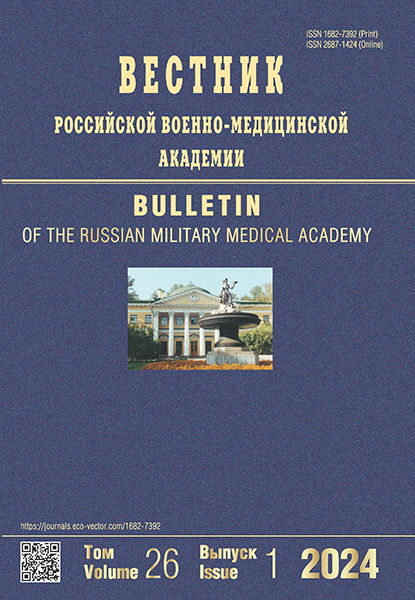女兵对卵巢月经周期不同阶段静动负荷的耐受性
- 作者: Blaginin A.A.1, Lapshina T.A.1, Emelyanov Y.A.1, Bakovetc D.V.1, Dudina E.A.1
-
隶属关系:
- Kirov Military Medical Academy
- 期: 卷 26, 编号 1 (2024)
- 页面: 71-78
- 栏目: Original Study Article
- ##submission.dateSubmitted##: 03.08.2023
- ##submission.dateAccepted##: 14.01.2024
- ##submission.datePublished##: 02.04.2024
- URL: https://journals.eco-vector.com/1682-7392/article/view/567974
- DOI: https://doi.org/10.17816/brmma567974
- ID: 567974
如何引用文章
详细
目前,俄罗斯武装部队中的女性在高等飞行学校接受培训,包括在战斗机航空部门。第一批女飞行员于 2022 年毕业。然而,现有的选拔制度包括对静态稳定性的评估和训练,它是基于男性的生理特点,并没有考虑到女性在卵巢月经周期期间体内荷尔蒙的周期性变化。尽管允许女性飞行的做法已有大约100年的历史,但关于妇女对静态动力学效应的耐受性(包括在卵巢月经周期的不同阶段)的研究结果却相互矛盾。考虑到卵巢月经周期的性质,研究了女军人在卵巢月经周期的不同阶段对静力负荷的耐受性。63 名女兵参加了本项研究。根据卵巢月经周期的变化情况,她们被分为 3 组。第一组(28人)卵巢月经周期规律,无经前综合征;第二组(26人)卵巢月经周期规律,有经前综合征;第三组(9人)服用复方口服避孕药。测试前、测试中和测试后都记录了生理指标(血压和心率)。通过在卵巢月经周期的卵泡期和黄体期进行 V.I. 沃伊切克的旋转测试 "耳石反应-10 "来模拟静力负荷。研究发现,在卵巢月经周期的不同阶段,第一组和第三组对他汀类药物的耐受性没有差异。在第二组中,卵巢月经周期的黄体期与卵巢月经周期的卵泡期相比,以及与第一组和第三组的卵巢月经周期的黄体期相比,对静态负荷的耐受性明显降低。此外,第二组在卵巢-月经周期的黄体期,循环系统对静力负荷的反应发生了变化,表现为心率值升高。因此,对于卵巢月经周期规律、无经前期综合征的女兵和服用复方口服避孕药的女兵来说,卵巢月经周期的阶段并不会影响对他汀类药物的耐受性。对于卵巢月经周期规律和有经前综合征的女军人来说,对静态负荷的耐受性取决于卵巢月经周期的各个阶段,在黄体期会有所减弱。
全文:
作者简介
Andrey A. Blaginin
Kirov Military Medical Academy
Email: andreyblaginin60@gmail.com
ORCID iD: 0000-0002-3820-5752
SPIN 代码: 2747-0146
MD, Dr. Sci. (Med.), Dr. Sci. (Psych.), professor
俄罗斯联邦, Saint PetersburgTatiana A. Lapshina
Kirov Military Medical Academy
编辑信件的主要联系方式.
Email: tanyaleningrad@bk.ru
ORCID iD: 0000-0002-5053-6490
SPIN 代码: 1874-7196
therapist
俄罗斯联邦, Saint PetersburgYury A. Emelyanov
Kirov Military Medical Academy
Email: Volandgm@yandex.ru
ORCID iD: 0000-0003-4803-3517
SPIN 代码: 6874-5924
MD, Cand. Sci. (Med.)
俄罗斯联邦, Saint PetersburgDmitry V. Bakovetc
Kirov Military Medical Academy
Email: dmitriibakovetc@mail.ru
ORCID iD: 0009-0001-4406-3981
SPIN 代码: 3031-2928
teacher
俄罗斯联邦, Saint PetersburgElizabeth A. Dudina
Kirov Military Medical Academy
Email: elizaveta-dudina@mail.ru
ORCID iD: 0000-0003-3834-1639
SPIN 代码: 6837-2069
senior laboratory assistant
俄罗斯联邦, Saint Petersburg参考
- Buynov LG. Statokinetic stability and approaches to its pharmacological correction. Reviews on clinical pharmacology and drug therapy. 2002;1(2):27–50. (In Russ.). EDN: HVENAT.
- Litvinenko IV, Samartsev IN, Zhivolupov SA, Morozova MV. Current concepts of the pathogenesis, prevention and treatment of the motion disease (seasickness). Marine Medicine. 2017;3(2):25–33. doi: 10.22328/2413-5747-2017-3-2-25-33
- Glaznikov LA, Buynov LG, Sorokina LA, Syroezhkin FA. Promising approaches in development of tools and techniques for enhancement the balance stability of aerospace specialists. Bulletin of the Russian Military medical academy. 2014;(2):104–110. EDN: SFEWYB
- Collins WE, Lentz JM. Some psychological correlates of motion sickness susceptibility. Aviation, Space, and Environmental Medicine. 1977;48(7):587–594.
- Lindseth G, Lindseth PD. The relationship of diet to airsickness. Aviation, Space, and Environmental Medicine. 1995;66(6):537–541.
- Grunfeld E, Gresty MA. Relationship between motion sickness, migraine, and menstruation in crew members of a “round-the-world” yacht race. Brain Res Bull. 1998;47(5):433–436. doi: 10.1016/s0361-9230(98)00099-9
- Lawther A, Griffin MJ. The motion of a ship at sea and the consequent motion sickness amongst passengers. Ergonomics. 1986;29(4):535–552. doi: 10.1080/00140138608968289
- Turner M, Griffin MJ. Motion sickness in public road transport: Passenger behaviour and susceptibility. Ergonomics. 1999;42(12):1646–1664. doi: 10.1080/001401399184730
- Mark S, Scott GBI, Donoviel DB, et al. The impact of sex and gender on adaptation to space: executive summary. J Women’s Health. 2014;23(11):941–947. doi: 10/1089/jwh.2014.4914
- Moriyama H, Itoh M, Shimada K, Otsuka N. Morphometric analysis of fibers of the human vestibular nerve: Sex differences. Eur Arch Otorhinolaryngol. 2007;264(5):471–475. doi: 10.1007/s00405-006-0197-5
- Friptu VG, Moldovanu IV, Mazur IA. A relationship of cyclic changes in sexual hormones to vegetative disorders in the development of premenstrual symptoms. Russian bulletin of obstetrician-gynecologist. 2015;15(6):24–29. EDN: VJLVIJ doi: 10.17116/rosakush201515624-29
- Girdler SS, Light KC. Hemodynamic stress responses in men and women examined as a function of the female menstrual cycle. Int J Psychophysiol. 1994;17(3):233–248. doi: 10.1016/0167-8760(94)90066-3
- Hastrup JL, Light KC. Sex differences in cardiovascular stress responses: Modulation as a function of menstrual cycle phases. J Psychosom Res. 1984;28(6):475–483. doi: 10.1016/0022-3999(84)90081-3
- Heitkemper MM, Jarett M, Caudell KA, Bond E. Women with gastrointestinal symptoms: Implications for nursing research and practice. Gastroenterol Nurs. 1998;21(2):52–58. doi: 10.1097/00001610-199803000-00005
- Mayer EA, Naliboff B, Lee O, et al. Review article: Gender-related differences in functional gastrointestinal disorders. Aliment Pharmacol Ther. 1999;13(2):65–69. doi: 10.1046/j.1365-2036/1999.00008.x
- Mills PJ, Berry CC. Menstrual cycle, race, and task recovery effects on blood pressure recovery from acute stress. J Psychosom Res. 1999;46(5):445–454. doi: 10.1016/s0022-3999(99)00015-x
- Clemes SA, Howarth PA. The menstrual cycle and susceptibility to virtual simulation sickness. J Biol Rhythms. 2005;20(1):71–82. doi: 10.1177/0748730404272567
- Matchock RL, Levine ME, Gianaros PJ, Stern RM. Susceptibility to nausea and motion sickness as a function of the menstrual cycle. Womens Health Issues. 2008;18(4):328–335. doi: 10.1016/j.whi.2008.01.006
- Prilepskaya VN, Dovletkhanova ER. Premenstrual syndrome: symptoms, diagnostics, phytotherapy (clinical lecture). Medical council. 2020;(13):106–115. EDN: QSTBIA doi: 10.21518/2079-701Х-2020-13-106-115
- Loginova KB, Dyukova GM, Dobrokhotova YuE. Premenstrual syndrome in the population of women of the Russian Federation (epidemiological survey). Russian journal of human reproduction. 2019;25(1):34–40. EDN: ZDDFFR doi: 10.17116/repro20192501134
- Blaginin AA, Zhiltsova II, Annenkov OA. Assessment of pilot functional state with computer posturography in conditions of statokinetic stress. Bulletin of the Russian Military Medical Academy. 2014;(2):134–137. EDN: SFEXAJ
- Blaginin AA, Sinelnikov SN, Lyashed’ko SP. Influence of different types of loads on quality of spatial orientation and operator activity of operators of an aviation profile. Bulletin of the Russian Military Medical Academy. 2018;(2):99–104. EDN: XRZEUH
- Agajanian NA, Radysh IV, Krayushkin SI. Chronostructure of reproductive function. Moscow: KRUK; 1998. 248 p. (In Russ.).
补充文件









